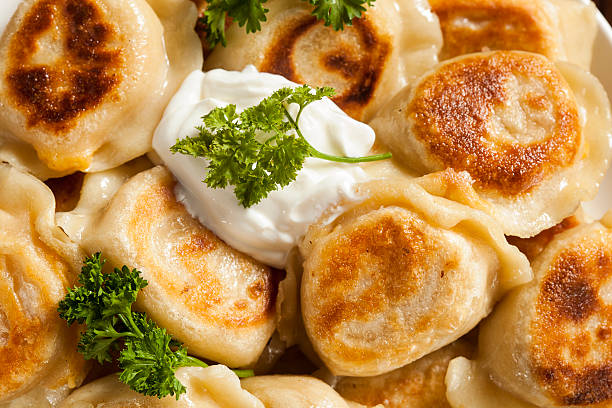Few dishes capture the soul of a country the way pierogi do for Poland. These humble dumplings, with their soft dough and delicious fillings, are more than just a meal they’re a connection to family, tradition, and home. Whether boiled, fried, or baked, pierogi are comfort wrapped in dough.

A Bite of History
The story of pierogi stretches back centuries. Historians believe they first arrived in Poland in the 13th century, brought by travelers from the East possibly inspired by Asian dumplings like Chinese jiaozi. Over time, Poles gave the dish their unique twist, turning it into a national treasure.Pierogi quickly became central to Polish celebrations and holidays. During Christmas Eve, when no meat is eaten, families serve pierogi z kapustą i grzybami (filled with cabbage and mushrooms). At Easter, sweet cheese or fruit versions make an appearance. Every bite carries the flavor of history and a touch of nostalgia.
What Exactly Are Pierogi?
At their core, pierogi are half-moon shaped dumplings made from soft dough and stuffed with various fillings.They resembles alot with Indian momos. The dough is simple flour, water, salt, and sometimes an egg or a little butter. It’s rolled thin, filled, and sealed by hand. Then comes the fun part: boiling until tender and finishing them in sizzling butter for that golden, crispy edge.The beauty of pierogi lies in their versatility. They can be savory, sweet, light, hearty, festive, or everyday food whatever the cook’s imagination allows.
Ingredients for Homemade Pierogi
For the Dough:
- 2 cups all-purpose flour (plus extra for dusting)
- 1 large egg (optional for elasticity)
- ½ cup warm water
- 1 tablespoon butter or oil (optional for softness)
- ½ teaspoon salt
For the Classic Pierogi Ruskie Filling (Potato and Cheese):
- 2 large potatoes, peeled and boiled
- 1 cup farmer’s cheese or cottage cheese (twaróg if available)
- 1 small onion, finely chopped
- 1 tablespoon butter or oil (for sautéing the onion)
- Salt and black pepper to taste
Traditional Fillings You’ll Find in Poland
Pierogi fillings vary by region, season, and family tradition. Here are a few of the most beloved:
- Pierogi Ruskie (Ruthenian Pierogi): The classic. A mix of mashed potatoes, white cheese (like twaróg), and sautéed onions. Creamy, slightly tangy, and deeply comforting.
- Pierogi z Kapustą i Grzybami: Filled with sauerkraut and wild mushrooms, this version is earthy and flavorful especially popular during Christmas.
- Pierogi z Mięsem: Stuffed with seasoned minced meat (often pork or beef), these are rich and satisfying.
- Sweet Pierogi: Filled with fruits like blueberries, strawberries, or sweet cheese, often served with sour cream or sugar.
Making Pierogi at Home
There’s something heartwarming about making pierogi from scratch. It’s not just cooking it’s crafting comfort with your hands.
Step 1: Prepare the Dough
Mix flour, a pinch of salt, and warm water until smooth. Add an egg if you want more elasticity. Knead the dough for about 10 minutes until it’s soft and flexible. Let it rest under a damp towel for 30 minutes.
Step 2: Choose Your Filling
Mashed potatoes and cheese are a good start for beginners. Sauté onions for flavor, mix them in, and season with salt and pepper.
Step 3: Shape the Pierogi
Roll out the dough thinly and cut out circles using a glass or cutter. Place a spoonful of filling in the center, fold, and pinch the edges tight. The key is to seal well so they don’t burst during boiling.

Step 4: Boil and Fry
Boil pierogi in salted water until they float (about 2–3 minutes). You can serve them right away or pan-fry in butter with onions until golden. The crispy, buttery finish adds pure magic.
How to Serve Pierogi
Poles take serving seriously. The simplest way is with melted butter and fried onions, but the possibilities are endless: with sour cream for a creamy tang, with crispy bacon bits for added crunch, with sugar and cream for sweet pierogi, or with fresh herbs and caramelized onions for aroma. Whether eaten hot from the pan or cold the next day, pierogi are always delicious.
Pierogi Beyond Poland
While Poland is their birthplace, pierogi have traveled far. Immigrants brought them to the U.S., Canada, and beyond, where they became symbols of comfort for Polish communities. In places like Chicago, Pittsburgh, and Toronto, pierogi festivals draw thousands each year.Different countries have their own takes Ukrainians make varenyky, Russians have pelmeni, and Slovaks make pirohy. Each one carries that same comforting essence: dough plus filling equals happiness.
Pierogi in Modern Cuisine
Today, pierogi are stepping out of grandma’s kitchen and into gourmet menus. Chefs are experimenting with bold new flavors think spinach and feta pierogi, pulled pork and barbecue pierogi, or chocolate dessert pierogi dusted with cocoa powder. Street food vendors sell mini pierogi bites, while upscale restaurants pair them with fine wines or craft beers. Despite these innovations, traditional versions remain timeless a reminder that good food doesn’t need to be complicated.
Tips for Perfect Pierogi
If you want to make your pierogi exceptional, remember these simple rules:
- Don’t overstuff — too much filling will make them burst.
- Seal edges tightly — use a little water or egg wash if needed.
- Don’t skip resting the dough — it helps elasticity and texture.
- Use good butter — Polish pierogi are all about buttery flavor.
- Fry before serving — that crisp exterior makes all the difference.
Storage and Freezing
Pierogi freeze beautifully. To store them, place cooked (or uncooked) pierogi in a single layer on a tray, freeze, then transfer to a container. When you’re ready to enjoy, just boil or pan-fry they’ll taste freshly made.it is better to store them uncooked as i say they gives there best flavours right after cooked.
Nutritional Facts
Pierogi are a hearty dish but can be surprisingly balanced. A typical serving provides carbs for energy, protein from cheese or meat, and vitamins from veggies or fruits. To make them lighter, use whole wheat flour or swap sour cream for yogurt. Like any comfort food, moderation is key but hey, a few extra pierogi never hurt anyone!
Pierogi in Culture and Festivals
Pierogi aren’t just food they’re part of Polish identity. Cities like Kraków, Warsaw, and Lublin hold annual Pierogi Festivals, where chefs compete for the best fillings and crowds devour thousands of dumplings. Music, laughter, and the irresistible smell of butter fill the air it’s pure joy.Food is also a great source of memories and relaxation in human nature good food can make person happy . In Polish homes abroad, making pierogi together is often a way to keep traditions alive. It’s not uncommon to find families spending an entire afternoon rolling, filling, and laughing together turning a recipe into a memory.
Why We Love Pierogi
What makes pierogi so special isn’t just the taste it’s the emotion. Each one tells a story of family, history, and care. From the first knead of dough to the last buttery bite, pierogi remind us that food is love made edible. They may look simple, but behind every pierogi is a legacy one that continues to warm hearts around the world.
FAQs About Pierogi
1. What’s the most traditional pierogi filling?
The classic pierogi ruskie filled with potatoes, cheese, and onions remains the most popular and traditional.
2. Can pierogi be made vegan?
Yes! Use water-based dough and fill them with mushrooms, cabbage, or lentils. Replace butter with plant-based margarine.
3. Are pierogi and dumplings the same?
They’re similar but not identical. Pierogi are Poland’s version of dumplings, usually boiled and then fried, with unique fillings and textures.
4. How do you reheat pierogi?
Fry them in a bit of butter or oil until hot and crispy. Avoid microwaving it makes them soggy.
5. What drinks pair best with pierogi?
Try them with sour cream and a light beer, white wine, or even a traditional Polish kompot (fruit drink).
Final Thoughts
Pierogi are a symbol of home warm, familiar, and made with love. Whether you grew up eating them or are just discovering them, these dumplings invite you to slow down, share, and savor. Every culture has its comfort food, and for Poland, it will always be the humble, heartwarming pierogi.
Please don’t forget to leave a review.
